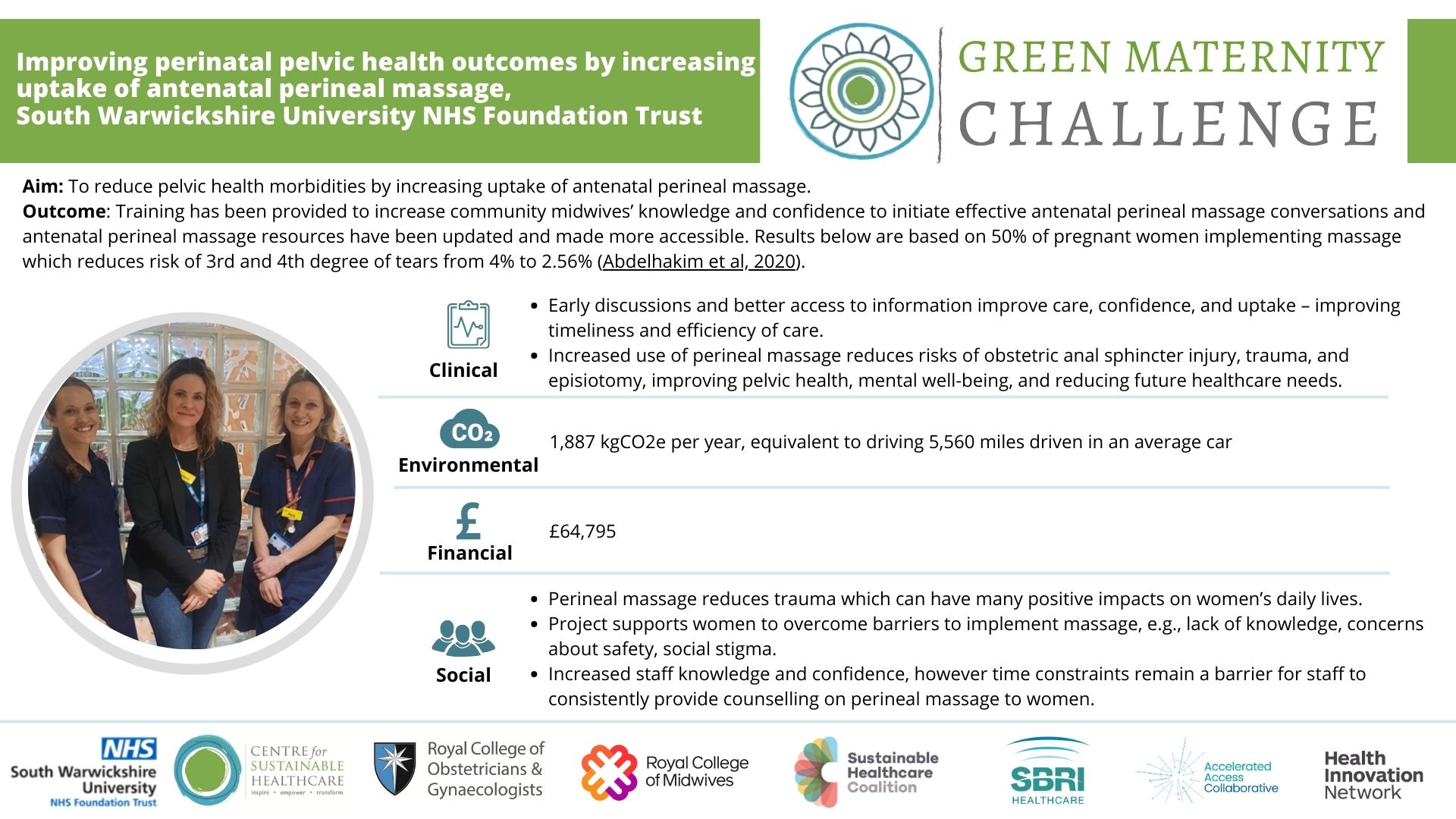Project completed as part of the National Green Maternity Challenge 2024-25 by the South Warwickshire University NHS Foundation Trust

Improving perinatal pelvic health outcomes by increasing uptake of antenatal perineal massage
Team members:
- Jennifer Prescot - Specialist Perineal Midwife
- Kathin Gray - Pelvic Health Midwife
- Posy Bidwell - Deputy Head of Midwifery – Maternity
Setting / patent group: Maternity Services
Issue: (should be summarised in background)
Vaginal birth can cause perineal trauma and damage pelvic health, leading to issues such as urinary & anal incontinence, pelvic organ prolapse and obstetric anal sphincter injury (OASI). All these alter a woman’s lifestyle and negatively affect their quality of life, mental health and relationships. For women experiencing OASI and pelvic health dysfunction, it can come with additional costs not only to them but also for the healthcare system, the environment and the society, in terms of resource heavy and prolonged treatments, lifestyle changes leading to increased resource use, negative effect on mental health and increased need for other healthcare services. Increase the uptake of antenatal perineal massage can help reduce perineal trauma and pelvic health dysfunction, preventing the overall negative impact of pelvic health dysfunction to themselves, the healthcare system, environment, and society. However, engagement in antenatal perineal massages among maternity care users remains to be low despite evidence stating its benefits. The exact rate of uptake and reasons for low uptake are not fully known. It could be due to various reasons such as limited knowledge regarding the massage, difficulty or unease experienced while performing the massage or unwillingness to perform it.
Intervention:
The aim of the project is to reduce pelvic health morbidities by increasing the uptake of antenatal perineal massage through various interventions like:
1. Increasing staff knowledge and confidence to initiate effective antenatal perineal massage conversations
2. Increase maternity service users’ confidence to initiate antenatal perineal massage
3. Increase the access and accessibility of antenatal perineal massage
This involved identifying stakeholders and studying the system to design effective improvements. A training package was developed for community midwives, along with online resources. This included PPT presentations as well as videos. A page dedicated to antenatal perineal massage was also built on the local online antenatal birth preparation course and the number of women who accessed that course was monitored. This gave more information about the massage and its benefits, and even had links to videos related to the massage. Surveys were conducted both for the staff and for maternity care users to measure the impact of the project.
Outcomes:
Environmental
Based on estimates, assuming 50% women who are educated on antenatal perineal massage proceed to uptake it, there would be a reduction in the total carbon footprint from 10,483 kgCO2e per year to 8,569 kgCO2e per year, with an annual savings of 1,887 kgCO2e.
Social
Knowledge about antenatal perineal massage increases staff knowledge and confidence to support pregnant women. The project also supports women to overcome barriers to implement massages, empowering them. Further, the project prevents disruptions to the lifestyle of a woman and other costs caused by pelvic health dysfunction.
Talks about the massage do require more time to be added to midwifery appointments, thereby making time as a constraint.
Clinical
Effective talks and information about antenatal perineal massage can improve care, confidence, and uptake of the massage, which provides timely and effective care to maintain pelvic health. Increased uptake of perineal massage also reduces risk of OASI, trauma, and episiotomy while benefitting pelvic health, mental well-being and reducing the load on healthcare.
Financial
Pathway mapping shows that cost for each case of OASI is £4,736.50. Assuming 50% of the women who are educated in perineal massage carry it out, studies show that there would be a saving of £64,795 annually.
Key learning point:
It was found that training improved staff knowledge and confidence to discuss massage. Still, more efforts need to be made, as dropout rates were found to be high even in small intervention groups. Even after training, it was felt ‘hard’ to have conversations on the topic. Universal training and adoption of this practice might normalise the massage and change general perception regarding it.
Please log in or sign up to comment.